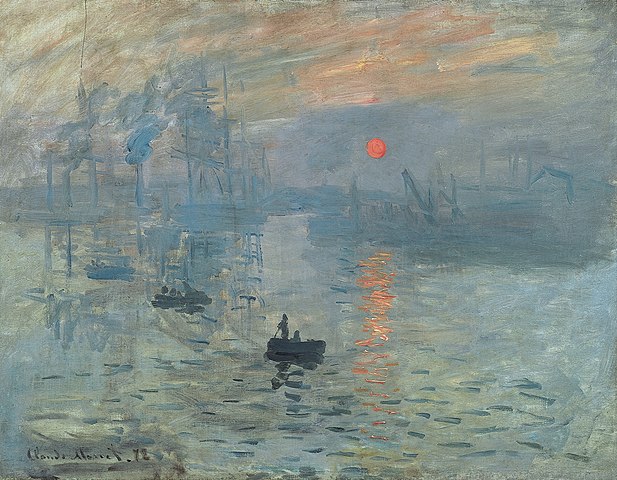
What is impressionism? It was a style of art where the artist was trying to capture an impression of the moment. Claude Monet is probably the most famous impressionist, and he was one of the few artists who was able to make money while he was alive.
Impressionism began in Paris in the late 1800s and was a rebellion against the classical style of painting that had gone before it. The idea was to represent the world as a person saw it at that exact moment in time, which meant to give an impression of what was being seen. To do this, they used light to define the moment and they ran colors into each other instead of using black lines.
Art has evolved throughout history. Each generation tries to change or improve upon what went before, but there have been various times when there have been huge jumps. Early art was either religious or used to glorify a rich person, or whoever had commissioned the art. In the 15th century, during the renaissance, art for the sake of art began and in 1415, the first painting to use perspective was created, changing the way pictures would be painted from then on. Artists had not tried for realism before this, but the use of perspective altered what artists could do. The Renaissance continued until about 1600 and produced many of the famous artists we know, such as da Vinci and Michaelangelo. Then came Baroque, which was an art style that tried to highlight the beauty of movement. Then came Rococo art, which tried to use contrasting light and dark to evoke emotion. Then came Romanticism, which was an attempt to use imagination to imbue a scene with mood, rather than just painting the scene as it was. Weather, clouds, and lighting were used to give the pictures a dramatic feel. And impressionism came on the back of Romanticism.
Impressionism began in the 1860s and it started when a group of painters, including Claude Monet, started to paint outside. Romantic artists went outside for inspiration, but they usually sketched and then went inside to finish their paintings, adding the dramatic elements from their imaginations. The impressionists wanted to get away from this and they wanted to paint what they actually saw, not what they thought they saw. As with many things, technology enabled them to do this. An American called John Rand invented oil paint in a tube, that could be used and then resealed. Impressionists could take this with them and they could paint where they actually were. The son of the artist Renoir said that without these paints in tubes, there would have been no Cezanne, Money, or Pissaro. There is no way of knowing if impressionism would have taken off without these paints, but paints in tubes certainly allowed the artists to paint outside, which they had to do to be impressionists. It allowed them to be spontaneous and to paint quickly, some of the key markers of impressionism.
Impressionism brought about several changes in painting style that hadn’t been seen before. The first was the brushstrokes. In classical paintings and those of the Romantics, you cannot see the brushstrokes. They are very carefully painted and all of the brushstrokes are carefully blended in to give a smooth overall picture. The impressionists wanted to paint the overall impression of the moment rather than individual details, so they used short and broken brushstrokes, often of unmixed colors. They didn’t blend the colors in or shade them, which gave the sensation of intense color. They were aided in this by the invention of synthetic pigments that were used in the tubes of paints, allowing them to use brighter colors than had been used before.
Impressionists also painted very quickly and more roughly than the painters before them. The Romantics went to great lengths to make everything look perfect, but the impressionists were just trying to get down an impression of what they were seeing. They used their new paint in tubes and painted as fast as they could. The Romantics would work on different parts of the picture for days on end, but the impressionists would work on the whole picture at the same time.
The impressionists paid a lot of attention to the light in the scene and they used contrasting colors to display the light, rather than using greys and darker colors for shadows. This gave the images many more dimensions of color.
Impressionist pictures and artists were very unpopular with art critics, but the public liked them a lot. In fact, the term “impressionist” was coined by the art critic Louis Leroy, who was making fun of Monet’s sunset painting, called “Impression: Soleil Levant”. He said that there must be some impression in it and it was less finished than an early design for a wallpaper pattern. He was being sarcastic, but the artists took up the name for their group. The artists from the impressionistic group are some of the most well-known artists and Louis Leroy is only remembered for coming up with their name. We should all be careful of what we joke about. And this is what I learned today.
Image by Claude Monet – wartburg.edu, Public Domain, https://commons.wikimedia.org/w/index.php?curid=5504881
Sources
https://en.wikipedia.org/wiki/Impressionism
https://www.tate.org.uk/kids/explore/what-is/impressionism
https://www.sothebys.com/en/art-movements/impressionism
https://link.springer.com/article/10.1007/s10824-023-09473-y
https://impressionistarts.com/was-van-gogh-an-impressionist#google_vignette
https://www.complex.com/style/a/christi-danner/artists-who-got-rich-before-they-died
https://www.history.com/topics/art-history/impressionism
https://en.wikipedia.org/wiki/John_G._Rand
https://www.jessenusbaum.com/blog/2022/5/4/the-9-most-influential-art-movements-throughout-history
http://op-art.co.uk/history/perspective/
https://www.oxfordartonline.com/page/1762
